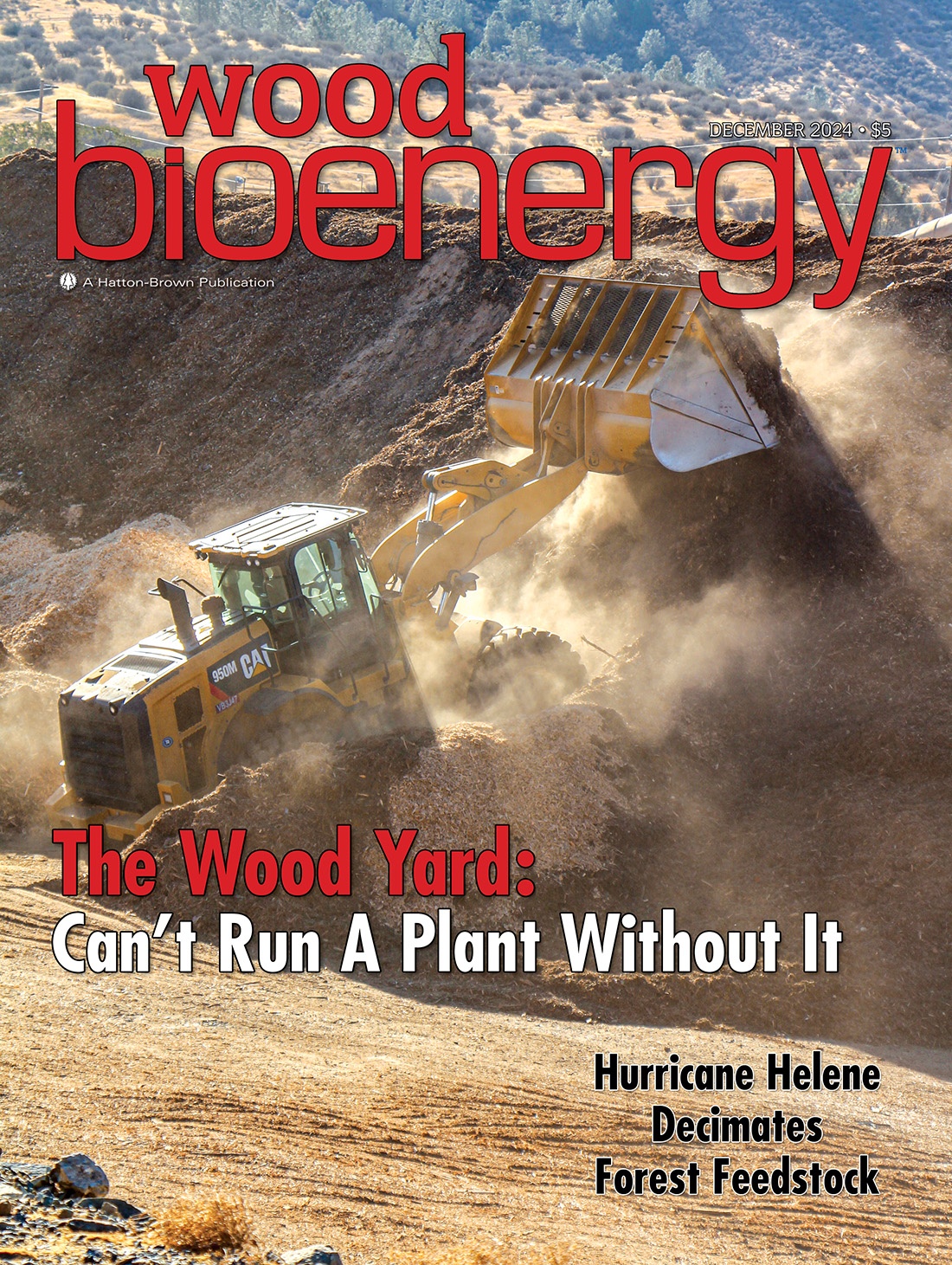Inside this issue
FROM THE EDITORS
IN THE NEWS
- TP&EE Had A Good Buzz
- Meth Brings Biomass To Javelin Commodities
- Coal-Firing In UK Goes Down In History
- Draft EIR Released For GSNR Project
- A Powerful Gathering
- FutureMetrics Offers Words Of Wisdom
- Atikokan Biomass Enters Contract
COVER STORY
HOW SPARK DETECTION WORKS
Fiber drying and storage opera- tions continue to be a critical safety challenge in many manufacturing facilities. In one case, the process involved drying wet fibrous material in ovens and then conveying it to storage buildings for later use. Past incidents of over-drying led to sparks and burning embers, which posed a significant risk to the storage areas.
WOOD YARD TECH
- BE&E
- Burton Mill Solutions
- FMW Industries
- John King Chains
- MDI
- Mid-South Engineering
- Precision-Husky
- Rawlings Wood Hogs
- Sennebogen
- Terrasource Global
- USNR
Find Us On Social
From the Editors
Are The Carolinas The Secret Again?
Before a large industrial pellet producer got a little too big for the britches as they say in the U.S. South, catapulting the two-state area into uncertainty, the Carolinas were a perfect feedstock area for woody biomass sourcing and production of pellets. Not only is the region rich in standing timber, it has an incredibly healthy logging force and pro-business climate. It was easy to see, even with continued pressure from environmental groups, why North and South Carolina attracted investors and pellet plants. How funny things can change over the years.
One of the best things for the landowners and loggers in the area was the price-driven competition; pellet mills taking both roundwood and chips were a welcomed addition for an area that had previously relied on packaging/pulp-and-paper markets for their lower value timber and chips. But now, the assumed to be done-deal expansions of those pellet mills, and traditionally consistent pulp-and-paper markets, is turning into a frightful reality for those same loggers and landowners. It’s (almost all) going up in smoke.
Officials with the International Paper Co. mill at Georgetown, SC wasted no time after announcing on Halloween the imminent closure of the facility by the end of the year. On November 1, the mill took delivery of its last load of logs, blowing a huge hole in the local logging economy as the mill took up to 400 loads daily.
The more than 6,000 loads a month that the mill paid for helped support hundreds of loggers and their employees who worked in its procurement area. Local economic officials say the impact in the logging industry alone could be more than 1,000 jobs in addition to the 674 high-paying jobs lost at the mill.
The Georgetown facility had been a major direct and indirect employer for the regional timber industry since 1937. One local official estimated the plant also worked with and provided opportunities for more than 200 local and regional contractors and suppliers of all kinds. The Georgetown mill produced about 300,000 tons of fluff pulp annually as well as an amount of uncoated freesheet paper that was filling a sales contract that expires December 31.
Crad Jaynes, President & CEO of the South Carolina Timber Producers Assn., called the decision “heartbreaking.” And the significance of the move can hardly be understated. While the mill hasn’t run at full capacity in a while, he said, the thousands of loads still delivered there every month play a huge part in the regional timber economy.
“This changes the profile of the timber industry in this state,” Jaynes says, noting that he’s hearing of loggers that worked with the facility parking multiple crews immediately. It also comes on the heels of the WestRock plant closure in North Charleston.
Jaynes adds that with so much wood looking for a home, remaining markets are reducing cut-and-haul rates. “It’s a ripple effect that’s devastating for the whole supply chain in that area,” he adds.
But what if this nightmare can be pivoted into a dream situation for the right investor in a biochar plant, or even a utility willing to convert to co-firing pellets as Dominion Power has done in Virginia since 2013, or a sawmill adding co-generation to their site? Once again, the area’s growth-to-drain ratio is out of whack. Meanwhile there are a whole lot of highly skilled workers and motivated city-county-state governments looking to bring industry back to the area.
From Left: Jessica Johnson, Managing Editor; Dan Shell, Senior Editor; Rich Donnell, Editor-in-Chief; David Abbott, Senior Associate Editor
Cover Story: Helene Impact Comes Into Focus
Weeks after Hurricane Helene made landfall on September 26, rescue and recovery efforts continue in several states, and the extent of the damage to timberlands is becoming clearer.
Hurricane Helene was a Category 4 storm when it hit the Big Bend region of Florida, a Category 2 by the time it crossed north of the Florida/Georgia state line, and was a tropical storm once it got to North Carolina.
According to a Timber Impact Assessment by Georgia Forestry Commission, Georgia was impacted by high winds and large amounts of rain throughout the eastern part of the state. Hurricane Helene entered Georgia as a Category 2 near Valdosta and progressed northeast toward Augusta, becoming a tropical storm as it entered South Carolina, North Carolina, and Tennessee. Georgia experienced winds ranging from 35- 100 MPH in the storm’s path and rain totals ranging from 4 to 12 in. impacted a large portion of forested, agricultural and urban landscapes.
Private forested land accounted for 88% of the impacted land ownership within the hurricane’s path. Storm damage was detected in multiple timber types across multiple counties, and damage was seen in all classes of pine stands as well as in hardwood riparian areas.
Timber damage throughout the hurricane’s path is most severe in thinned chip-n-saw and sawtimber stands, causing significant impacts to this timber resource. Moderate to light damage is commonly seen in pulpwood stands throughout the main path. In general, pine stands with higher densities typically fared better than thinned stands with lower densities. Hardwood riparian areas suffered severe damage respective to stand type, due to saturated soils and hardwood crowns that contained all their foliage which caught the heavy winds and either snapped trees or uprooted them. Premerchantable timber stands weathered the storm the best and typically only suffered light damage.
Want more content?
Wood Bioenergy is published and delivered 6 times per year tosubscribers worldwide. Readership includes corporate executives, mill ownership, mill management, logging contractors and equity venture interests. Wood Bioenergy is FREE to qualified readers.
Latest News
Drax Ceasing Operations In Williams Lake, BC
Drax Ceasing Operations In Williams Lake, BC Drax has made the difficult decision to cease operations at its pellet plant in Williams Lake, B.C. The curtailment and closures of neighboring sawmills and the loss of a bid for key local supply have led to a significant...
UK Government Signs Contract With Drax
UK Government Signs Contract With DraxDrax confirms it has signed a contract with the UK Government for a low-carbon dispatchable CfD (Contract for Difference) agreement to cover all four biomass units at Drax Power Station over the period April 2027 to March 2031....
Biomass Plant Coming To South Carolina
Biomass Plant Coming To South CarolinaStartup company Carolina Renewable Products recently announced a new biofuel plant to be located near Orangeburg, SC. The company’s $280 million investment will create 155 new jobs. The company plans to convert sustainable woody...
Logger Co-op Launches Wisconsin Chip Mill
Logger Co-op Launches Wisconsin Chip Mill A precedent-setting milestone was marked in Tilleda, Wis., with the launch of the United States’ first chip mill owned and operated by a logger cooperative—a major step forward for collaboration and sustainability in the...
Brunette Machinery Acquires Salem Machinery
Brunette Machinery Acquires Salem MachineryBrunette Machinery Co. Inc. announced its asset purchase of Salem Equipment Inc., a longtime leading U.S. manufacturer of sawmill machinery. According to Brunette Machinery, the acquisition strengthens the company’s North...
Ninth Wood Bio Conference Gathers Steam For Atlanta
Ninth Wood Bio Conference Gathers Steam For AtlantaOrganizers of the ninth Wood Bioenergy Conference & Expo have released the first wave of speakers for the event, which will be held April 14-15, 2026 at the Omni Atlanta Hotel at Centennial Park in Atlanta, Ga....
Subscribe to Our Newsletter
Wood Bioenergy News Online hits the inboxes of subscribers in the wood-to-energy sectors.
Subscribe/Renew
Wood Bioenergy is published and delivered worldwide 6 times per year. Free to qualified readers in the U.S. Subscribers outside the U.S. are asked to pay a small fee.
Advertise
Complete the online form so we can direct you to the appropriate Sales Representative.


